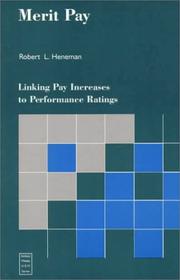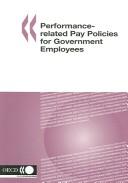| Listing 1 - 10 of 144 | << page >> |
Sort by
|
Book
Year: 1967 Publisher: Bruxelles : Commission des communautés européennes (C.C.E.),
Abstract | Keywords | Export | Availability | Bookmark
 Loading...
Loading...Choose an application
- Reference Manager
- EndNote
- RefWorks (Direct export to RefWorks)
DROIT SOCIAL --- SALARY SURVEYS --- SALARIES --- EMPLOYMENT --- ECONOMIC SURVEYS --- POLITICAL INTELLIGENCE --- DROIT SOCIAL --- SALARY SURVEYS --- SALARIES --- EMPLOYMENT --- ECONOMIC SURVEYS --- POLITICAL INTELLIGENCE

ISBN: 0585019517 9780585019512 0814479650 Year: 1998 Publisher: New York : AMACOM,
Abstract | Keywords | Export | Availability | Bookmark
 Loading...
Loading...Choose an application
- Reference Manager
- EndNote
- RefWorks (Direct export to RefWorks)
Compensation management. --- Commerce --- Business & Economics --- Marketing & Sales --- Compensation administration --- Wage and salary administration --- Personnel management --- Wages
Book
ISBN: 9783110315752 3110315750 1306091977 3110315580 Year: 2013 Publisher: Berlin ; Boston : De Gruyter,
Abstract | Keywords | Export | Availability | Bookmark
 Loading...
Loading...Choose an application
- Reference Manager
- EndNote
- RefWorks (Direct export to RefWorks)
Arbeitnehmer werden nicht mehr nur als Kostenfaktor betrachtet, der möglichst minimiert werden sollte, vielmehr wird ihnen ein Anteil an der Wertschöpfung beigemessen. Ihr Beitrag zum Unternehmenserfolg in Form ihrer Arbeitsleistung soll entsprechend honoriert werden.Diese Erkenntnisse führten zur Idee der variablen Vergütungssysteme. Diesen ist immanent, dass sie gleichzeitig eine Anreizwirkung und eine Belohnungsfunktion innehaben. Zum einen werden Mitarbeiter zu höheren Leistungen motiviert und für diese mit einem leistungs- bzw. erfolgsabhängigen Vergütungsbestandteil entlohnt. Zum anderen wird dabei eine Übereinstimmung der Handlungen der Arbeitnehmer mit den Unternehmenszielen angestrebt. Arbeitgeber müssen bei der Ausgestaltung variabler Vergütungssysteme sehr genau auf die Formulierung achten. Die Rechtsprechung des BAG fordert, dass diese Systeme klar und transparent ausgestaltet sind. Unklarheiten gehen im Zweifel zulasten des Unternehmens.
Wage payment systems. --- Merit pay. --- Merit increases --- Merit pay programs --- Merit pay systems --- Merit-type salary schedules --- Pay for performance --- Salary schedules, Merit-type --- Variable pay --- Performance awards --- Wages --- Pay structure --- Compensation / Law, compensation systems.
Book
ISBN: 9264007563 Year: 2005 Publisher: Paris : OCDE,
Abstract | Keywords | Export | Availability | Bookmark
 Loading...
Loading...Choose an application
- Reference Manager
- EndNote
- RefWorks (Direct export to RefWorks)
Une augmentation de salaire pour récompenser une meilleure performance : une telle politique peut-elle être bénéfique dans le secteur public ? Ce livre présente une vue d’ensemble des politiques de rémunération liée aux performances (RLP) dans l'administration. Il rend compte de l’expérience de 14 pays au cours des 20 dernières années. Il examine aussi bien les avantages que les faiblesses des politiques de RLP. Cet ouvrage explore les diverses voies empruntées par les pays pour mener à bien leurs réformes. Il s’attache à comprendre les raisons pour lesquelles les politiques de RLP sont mises en œuvre et comment ces politiques opèrent concrètement. Les résultats des politiques de RLP sont évalués tant au niveau de l'individu qu'au niveau des équipes. Des recommandations sont proposées pour faciliter la mise en œuvre des politiques de RLP et éviter certains obstacles. Ce livre, qui puise largement dans les rapports préparés par les pays, tire les leçons de deux décennies d'expérience en matière de politiques de RLP. Il évalue également l’impact de ces politiques sur l'efficience du secteur public. Pays couverts Allemagne, Canada, Chili, Corée, Danemark, Espagne, Finlande, France, Hongrie, Italie, Nouvelle-Zélande, Royaume-Uni, Suède et Suisse.
Merit pay --- Compensation management --- OECD countries --- Officials and employees --- Salaries, etc. --- Compensation administration --- Wage and salary administration --- Merit increases --- Merit pay programs --- Merit pay systems --- Merit-type salary schedules --- Pay for performance --- Salary schedules, Merit-type --- Variable pay --- OECD member countries --- Organisation for Economic Co-operation and Development countries --- Personnel management --- Wages --- Performance awards

ISBN: 0201525046 Year: 1992 Publisher: Reading, Mass. Addison-Wesley
Abstract | Keywords | Export | Availability | Bookmark
 Loading...
Loading...Choose an application
- Reference Manager
- EndNote
- RefWorks (Direct export to RefWorks)
Compensation management --- Merit pay --- 65.015 --- Merit increases --- Merit pay programs --- Merit pay systems --- Merit-type salary schedules --- Pay for performance --- Salary schedules, Merit-type --- Variable pay --- Performance awards --- Wages --- Compensation administration --- Wage and salary administration --- Personnel management --- 65.015 Work study and analysis. Method study --- Work study and analysis. Method study

ISBN: 9264007539 9789264007550 9789264007536 9786610356133 1280356138 9264007555 Year: 2005 Publisher: Paris : OECD,
Abstract | Keywords | Export | Availability | Bookmark
 Loading...
Loading...Choose an application
- Reference Manager
- EndNote
- RefWorks (Direct export to RefWorks)
This report presents an overview of performance-related pay policies (PRP) for government employees in selected OECD member countries over the past two decades. Both the strengths and the weaknesses of PRP policies are assessed. The report explores the various paths of reform in each country, investigating the reasons why PRP policies are being implemented and how the policies operate concretely. The outcomes of PRP policies at the individual and team levels are evaluated, and recommendations are made on what should be done or avoided with the implementation of PRP. The report includes a number of case studies.--Publisher's description.
Sociology of policy --- Personnel management --- Merit pay --- Compensation management --- OECD countries --- Officials and employees --- Salaries, etc. --- Compensation administration --- Wage and salary administration --- Wages --- Merit increases --- Merit pay programs --- Merit pay systems --- Merit-type salary schedules --- Pay for performance --- Salary schedules, Merit-type --- Variable pay --- Performance awards --- OECD member countries --- Organisation for Economic Co-operation and Development countries
Book
ISBN: 2708103733 9782708103733 Year: 1978 Publisher: Paris: Éditions d'organisation,
Abstract | Keywords | Export | Availability | Bookmark
 Loading...
Loading...Choose an application
- Reference Manager
- EndNote
- RefWorks (Direct export to RefWorks)
Personnel management --- Compensation management --- AA / International- internationaal --- FR / France - Frankrijk --- 332.27 --- Loonpolitiek. --- Compensation administration --- Wage and salary administration --- Loonpolitiek --- Wages

ISBN: 0028740599 Year: 1996 Publisher: New York : Free Press,
Abstract | Keywords | Export | Availability | Bookmark
 Loading...
Loading...Choose an application
- Reference Manager
- EndNote
- RefWorks (Direct export to RefWorks)
Compensation management --- Salaires --- Gestion --- loonvormen --- verloningssysteem --- 658.32 --- Compensation administration --- Wage and salary administration --- Personnel management --- Wages --- Salaries. Wages. Remuneration. Pay --- 658.32 Salaries. Wages. Remuneration. Pay
Book
Year: 2018 Publisher: Washington, D.C. : The World Bank,
Abstract | Keywords | Export | Availability | Bookmark
 Loading...
Loading...Choose an application
- Reference Manager
- EndNote
- RefWorks (Direct export to RefWorks)
Using online job portal data and probabilistic regression estimations, the paper investigates the explicit gender bias and salary gap in the Indian job market, reflected in more than 800,000 job recruitment advertisements. Exploring formal and informal sector occupations, the study finds high existence of employers' gender bias in hiring. Explicit gender preferences are highly job specific, and it is common to mention the preferred gender in job ads, which, in general, favor men over women. Although ads for professional occupations exhibit less explicit gender bias, they are not gender neutral. In all types of professional jobs, irrespective of the share of ads with preference for men or women, on average, ads targeting men specify/offer much higher salary. Employers in elementary sectors as well as blue-collar jobs express more segregated gender preference. The findings support the existing research that argues women are more preferred in low-quality, low-status, typically low-paid informal jobs. Targeting women for low-quality jobs explains half of the mean offered salary gap specified in ads; the rest is direct gender bias. The paper also suggests that, with the rise of new technology and sectors, gender bias in hiring in those new types of jobs is expected to decline.
Employer --- Gender --- Gender Bias --- Gender Preference --- Gender Targeting --- Hiring Bias --- Job Portal --- Labor Policies --- Law and Development --- Recruitment --- Salary Gap --- Social Protections and Labor
Book
Year: 2017 Publisher: Washington, D.C. : The World Bank,
Abstract | Keywords | Export | Availability | Bookmark
 Loading...
Loading...Choose an application
- Reference Manager
- EndNote
- RefWorks (Direct export to RefWorks)
Since the 1990s, India has seen robust economic growth, rising wages, steady fertility decline, increased urbanization, and expanded educational attainment for males and females. But unlike other countries that have undergone similar transitions, urban women's employment has refused to budge, never crossing the 25 percent mark. This paper fills a critical gap in policy research on women's employment in India. The discussion is situated in the normative construction of motherhood and the gendered nature of caregiving in India. The analysis uses pooled data from six rounds of the National Sample Surveys to examine the effects of having a young child on mothers' employment in urban India over 1983-2011. The analysis also looks at household structure, and analyzes the effects of other household members on women's labor supply. The results show that although the onus of childbearing may have reduced, that of caregiving has increased. Having a young child in the home depresses mothers' employment, an inverse relationship that has intensified over time. Further, living in a household with older children and women over the age of 50 is positively associated with women's employment. These results show that the care of young children is an increasingly important issue in women's employment decisions, in a context where formal childcare is practically nonexistent. These results have significant implications for policy to raise women's labor force participation in India.
Child Bearing --- Childcare --- Depression --- Employment --- Fertility Rates --- Healthcare --- Household Income --- Household Survey --- Income Group --- Incomes --- Living Standards --- Motherhood --- National Surveys --- Risks --- Salary --- Wages --- Women
| Listing 1 - 10 of 144 | << page >> |
Sort by
|

 Search
Search Feedback
Feedback About UniCat
About UniCat  Help
Help News
News